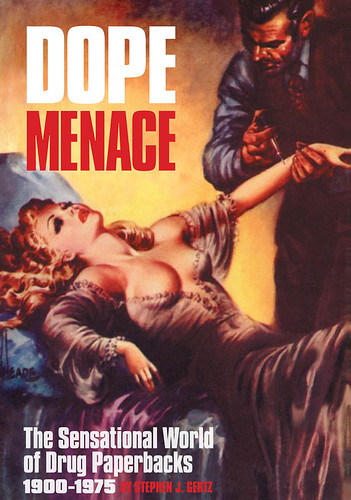Winter 2008
Sex and pulp and rock’n’roll
Dope Menace: The Sensational World of Drug Paperbacks 1900-1974
By Stephen J. Gertz Feral House, www.feralhouse.com/ordering, $24.95

In 1952, US Congressman Ezekiel C. Gathings singled out pocket-sized, mass-market paperbacks as being for ‘adults of low ethical standards’. He meant pulp books exploiting sex, violence, crime, and drugs, rather than cheap reprints of standard literature. Although all were indeed popular ‘low ethical’ themes, the last has provided the pretext to cover all bases in one handy volume. Stephen J. Gertz’s Dope Menace is no mere collection of pop-culture ephemera but a record of how drugs have long played a prurient role in art and literature both high and low.
While the majority of the covers conform to the pulp conventions, there are some that are religious in tone. The Moloch of Marihuana (1943), by the aptly named Rev R. J. Devine, is a cautionary tale with a cover that suggests underground comix of the sex, drugs and rock’n’roll era. Dope (1937), by Earle Albert Rowell, is a more empathetic view of the horrors of addiction. For the most part, though, these covers may represent horror but, like Marijuana Girl (1960) by the ubiquitous N. R. DeMexico, illustrated by pulp master Al Rossi, do so in (for some) a sultry and sexy manner.

This book is full of what you’d expect from the word ‘Menace’ in the title, but there is also a generous sampling of late 1960s hippie and psychedelic culture. While no less prurient, the artwork for the likes of Narco Nympho (1967) illustrated by Robert Bonfils, is more abstract. But if there is to be just one favourite, I will pick The Fraternity of Shame (1966). Here, Bonfils shows he is the best artist of erotic depravity in the business.
Steven Heller, design writer, New York
First published in Eye no. 70 vol. 18, 2008
Eye is the world’s most beautiful and collectable graphic design journal, published quarterly for professional designers, students and anyone interested in critical, informed writing about graphic design and visual culture. It is available from all good design bookshops and online at the Eye shop, where you can buy subscriptions and single issues.

